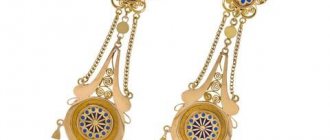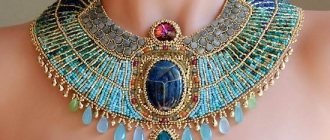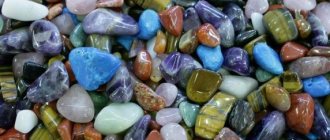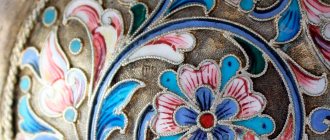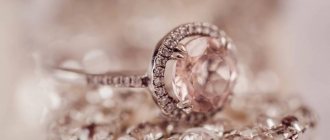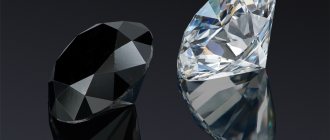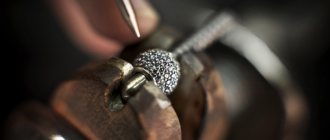Styles replaced each other - sometimes thanks to the powers that be (Louis XV, Napoleon Bonaparte, Queen Victoria, Ludwig of Bavaria), and sometimes simply due to a decline in public interest. Styles that are centuries distant from us are considered "historical" (Gothic, Renaissance, Baroque, Classicism, Romanticism). And those separated from us by 70 years or closer, perhaps, can be considered "relevant" styles (cubism, primitivism, steampunk and the like). Our next article will be about current styles.
When describing the characteristics of style , the following concepts are used: composition, line, color scheme, materials; in historical styles - ornament and its elements. Speaking of historical styles: “sometimes they come back” in the form of neo-styles - sometimes with great success (after all, technologies are improving). A striking example is the same Gothic. By the way, styles received their names very, very “retroactively”, often different in different countries .
For example, in the West (in England and countries that were influenced by the United Kingdom) the following classification of jewelry styles is accepted:
- Georgian (1714-1837) - “Georgian style” - the era of the reign of Kings George 1, 2, 3 and 4
- Victorian (1837-1901) - “Victorian style” - the era of the reign of Queen Victoria (1837-1890) the Romantic Period (1837-1861) (“romantic” period)
- the Grand Period (1861-1880) (“grand”)
- the Aesthetic Period (1880-1901)
So, looking back with hope at historical cinema (“Elizabeth: The Golden Age”, “Pirates of the Caribbean”, “Midshipmen” and the like), let’s try to start with the main historical styles - Baroque, Rococo, Classicism and Empire .
According to the Western classification, all these styles practically fit into the Georgian era .
History of Baroque jewelry style
Let's start with the fact that in addition to Baroque, there are different styles in jewelry, for example:
- Roccoco (curved asymmetrical patterns, graceful shapes)
- Classicism (strict, simple forms with refined details and frequent use of stones)
- Empire style (symmetry and appeal to ancient Roman forms)
- Victorian style (realistic reproduction of nature)
- Art Nouveau , also known as Art Nouveau (smooth elongated forms inspired by the plant world)
- Art Deco (geometric motifs, abstract shapes)
- Eclecticism , also known as Fusion (combination of different jewelry styles)
"Baroque" translated from Italian (barocco) means "whimsical." In Portugal, this was the name given to large, irregularly shaped pearls. This style of European culture originated at the end of the 16th - beginning of the 17th century and lasted throughout the 18th century. Baroque is characterized by pomp, splendor, emphasized solemnity and luxury, sensuality, rejection of strict, simple forms and canons in favor of diversity, a combination of contrasts, the idea of the world and of man as something ever-changing and complex. The style has made itself known on a large scale in such art forms as architecture, sculpture and painting, literature, dance and music, and jewelry.
Jan Vermeer "Girl with a Pearl Earring" (1665)
Peter Paul Rubens. Portrait of Elena Furman in wedding attire (c. 1630–1631)
Baroque as a phenomenon of culture and art has Italian roots, as you already understood. But its laws were first translated into the “language” of jewelry in France. It is also believed that it was in the Baroque era that the division of jewelry into daytime and evening jewelry appeared . Admiring the paintings of the great masters of the past: Rubens, Vermeer, Caravaggio, Velazquez, Van Dyck, you can see what kind of jewelry was worn in that era and understand why their theatrical beauty is so attractive and inspiring to modern designers.
Cultured pearls
the cultivation of pearls - the extraction of natural gems is prohibited at the legislative level. The coasts of Japan and China are almost entirely occupied by sea farms, where baroque pearls of variable (arbitrary) or specific, specified shapes are grown.
Bivalve marine mollusks - oysters, mussels, scallops are placed in a nutrient substrate. One in ten oysters contains a baroque pearl. The ripening period ranges from seven to ten years. To obtain pearls of a certain shape, a base of a given shape is placed in mollusk shells. In China, pearls are sectioned in this way in the form of an image of Buddha.
Main features of the Baroque jewelry style
Materials and decoration techniques. Yellow gold, large pearls, enamel, diamonds, rubies, emeralds, sapphires, topazes.
Forms of decorations. Large, often voluminous, oval, with rounded corners or wavy.
Leading motifs in jewelry design. Floral, floral, heraldic ornament; symmetry and rhythm, clarity of relief and clarity of design; rich, rich colors, gilding, abundance of decor.
Typical decorations.
- If these are brooches , then “bows”, “bouquets” or “branches”;
- baroque style earrings
- If this is a necklace , then it is a “sklavage” (resembles an openwork collar, and must have a pendant that falls into the hollow of the chest);
- The rings are necessarily massive;
- Baroque pendants
- Paired bracelets made of pearls or gold with precious stones;
- Hair ornaments.
Baroque non-pearl pearls
Formally, non-pearl pearls do not belong directly to the Baroque group, but their shape, shine, and color range do not allow them to be separated into a separate category.
"Melo melo"
It is also called sun pearl, because the color shades contain a wide palette of colors from yellow to red.
- Color: shades of orange, yellow, red and brown.
- Shape: round.
- Surface: matte, with sun flares.
- Dimensions: up to 25 mm in diameter.
On the coast of the South Asian seas, the rare Melo-Melo snail lives, and, like mollusks, it produces beads from calcium deposits. Formally, these are not pearls, but in jewelry, melo melo is classified as a group of baroque pearls. Due to the special surface of melo melo, it is impossible to fake, and the cost of a copy for one carat starts from 6 thousand dollars.
One of the most famous specimens of Melo Melo, the size of a golf ball and weighing 397 carats, was sold for $500,000.
"Co Hog"
Baroque “non-pearls” are produced by shells of the same name, whose habitat is limited to the Atlantic coast of North America.
- Color: all shades from milky white to black.
- Shape: round.
- Surface: matte, with slight shine.
- Dimensions: up to 15 mm in diameter.
The most valuable and suitable for jewelry are considered to be perfectly round specimens of a lilac hue - the possibility of finding such a pearl is estimated as a chance of 1 in 100,000. The second most popular are pearls in the shape of a tear, drop, or button. The rest are practically meaningless.
"Conk"
The birthplace of this “non-pearl” is the coast of the countries and island states of the Caribbean. The mollusk of the same name dies when the pearl is removed, so it is impossible to cultivate the conch.
- Color: all shades of pink.
- Shape: round, oval.
- Surface: matte, with slight shine.
- Dimensions: up to 20 mm in diameter.
The most valuable and quite rare specimens are considered to be regularly round in shape, pink with shades of lilac.
Style as part of... style
Baroque was originally part of evening fashion . Eye-catching jewelry goes well with bright makeup, a complex high hairstyle, clothes made of satin, silk, velvet, with draperies, ruffles, lace trim, lacing, embroidered with rhinestones or sequins (historically, in their place there were precious stones, which felt comfortable in the wardrobe of rich aristocrats themselves even on belts, shoe buckles and buttons). Baroque jewelry can also be added to an everyday look , especially with denim, knitwear, natural or faux leather, lace, silk or organza. Just reduce the “dose” of accessories on an everyday basis to one or two, for example, a cuff and brooch or a bracelet and ring.
Lapidarium
genre of symbolic literature of the Middle Ages. It described the special magical properties of stones and their symbolic meaning, echoing Christian teachings.
An influential poetic lapidary is Liber lapidum , (“Book of Stones” or “Book of Stones”). He describes the properties of sixty stones.
Compiled between 1061 and 1081 by Bishop Marbod of Rennes and was regularly reprinted.
The stone inserts are polished to cabochons until the end of the era. Enameling remains a popular technique for creating colorful scenes and details.
Characteristic decorations for the Middle Ages:
buttons, hair clips, hat badges, rings, weapon decorations, coronets, brooches, bracelets, brooches, chains with pendants (crosses, medallions).
Rings were worn on several fingers.
Hat decorations were popular during the late Middle Ages and early Renaissance. They could convey messages about the owners: initials, short mottos, coats of arms, allegorical or secular themes. Some such badges were worn by pilgrims and conveyed moral messages.
Baroque jewelry on the catwalk
Perhaps the most devoted fan of the baroque style (more precisely, neo-baroque, as magazines call it) for several seasons in a row is the fashion house Dolce&Gabbana. So at the show of ready-to-wear collections for spring-summer 2016, models demonstrate hair bands, headbands, massive earrings with figurines of angels, artificial pearls, false rubies, imitation flowers, leaves, and fruits. Oscar de la Renta and Alexander McQueen are fascinated by such a striking and dramatic baroque accessory as girandole earrings. Gucci and Chanel are partial to flower brooches. In addition, at Gucci you can’t take your eyes off large rings with lavish decor, and at Chanel, you can’t take your eyes off paired bracelets with pearls and silver figured inserts.
Dolce & Gabbana, spring-summer 2016
Gucci, spring-summer 2016
Chanel, spring-summer 2016
Baroque pearls - natural or artificial
All pearls are conventionally divided into natural (natural, or wild - other names) and cultured. By origin – sea or river. At the same time, cultured pearls cannot be called a fake - unlike their plastic painted imitations, cultured pearls are produced from shellfish shells on sea farms in conditions as close as possible to the natural habitat.
Thus, the natural technology of pearl growth is not disrupted. The main difference from wild pearls is the ability to adjust the shape, color, quantity and ripening period of pearls. Sea cultured pearls grow faster, freshwater river pearls are smaller, but the number of pearls in a shell can reach 100 pieces. Japan is a leader in the cultivation of exclusive pearls.
Among baroque pearls, “La Peregrina” is considered one of the most expensive specimens. The pear-shaped pearl weighs 6.5 g and has a diameter of 23.8 cm. The copy is valued at $10 million. The milky-white “Wandering Pearl” is included in the Guinness Book of Records and has been an adornment of the collections of the ruling Houses of Europe for many years.
Baroque jewelry on the red carpet
We can safely say that not a single ceremony is complete without luxurious baroque jewelry. Thus, at the 2016 Met Gala Costume Institute, Anna Wintour's daughter Bee Shaffer looked irresistible in Fred Leighton diamond girandole earrings , and actress Kate Bosworth adorned her hair with an exquisite Dolce&Gabbana wreath made of white gold , again encrusted with diamonds.
At the premiere of Woody Allen's film High Life last night at Cannes, Hollywood diva Naomi Watts showed off an elegant multicolor Bulgari necklace in a baroque style . And Spanish film actress Adriana Ugarte blew kisses to fans from the red carpet of the drama “Juliet” by Pedro Almodóvar - this film became one of the most anticipated and discussed films of the Cannes 2016 festival. “Juliet”-Adriana wore dangling earrings and a massive Chaumet ring with sapphires and unusual round-cut diamonds .
Kate Bosworth at Met Gala 2016
Naomi Watts at the premiere of Woody Allen's film High Life in Cannes 2016
Adriana Ugarte at the premiere of Pedro Almodovar's "Juliet" in Cannes 2016
Well, to curb our jewelry appetite, let’s take a look at the red carpet of the main foreign film award of the year. Alicia Vikander's best jewelry at the 2016 Oscars was her charming smile, and elegant Louis Vuitton diamond earrings with heraldic motifs in the design (Emily Blunt also had similar jewelry) and... the coveted gold statuette for Best Supporting Actress in the film "The Girl from Denmark." Alicia was not separated from Brie Larson at the Oscar reception, because she also became the heroine of the evening, having received an Oscar for her leading role in the drama “Room”. Brie's elegant hairstyle was accessorized with a Niwaka diamond flower brooch .
Alicia Vikander at the 2016 Oscars
Emily Blunt at the 2016 Oscars
Brie Larson at the 2016 Oscars
Geography of the gem
Baroque pearls of marine origin are mined in the Persian Gulf, Red, Mediterranean and Adriatic seas. Freshwater pearls can be found in rivers in Russia, China, Germany and North America.
“Head of Allah” is another example of an exclusive baroque pearl. The weight of the pearl, which looks like a head in a turban, is 6,720 grams, its diameter is 24 cm. According to legend, the pearl is of artificial origin. The philosopher Lao Tzu placed three bas-reliefs inside oysters. From generation to generation, Lao Tzu's descendants transplanted the growing pearls into larger oysters. One day, during a storm, one of the oysters was lost. It is believed that the “Head of Allah” discovered in the Philippines is the lost pearl of Lao Tzu. According to experts, the copy costs at least $40 million.
Who is suitable according to their zodiac sign?
“Tears of an angel” (one of the names of pearls) appeals to water signs of the zodiac. They are most suitable for Cancers - they restrain negative manifestations of character, protect against bad intentions, restrain grievances and promote self-affirmation in the personal and professional sphere. Cancers, Pisces and Aquarius can wear jewelry with baroque pearls of any shade.
Aries are not recommended to choose pearls of silver, gray or steel shades. Virgos need to avoid black pearls - they can enhance negative manifestations of character, melancholy and suspiciousness of representatives of this sign.
Leos and Geminis should stick to light and pastel colors of pearls.
For Scorpios and Capricorns, black, gray or mother-of-pearl baroque pearls are more suitable, preferably in combination with silver metals.
For Taurus, Libra and Sagittarius there are no contraindications for the color or combination of baroque pearls.
The magical properties of baroque pearls
Residents of the Celestial Empire endowed baroque pearls with magical powers, used accessories and amulets with them in fertility rituals, and considered them a symbol of youth and longevity. Mongolian, European and Arab rulers traditionally used pearls as a symbol of power. It was believed that pearls could recognize poisoners: for this, pearls were placed in drinking cups, and dishes inlaid with pearls were an indicator of poisons.
Regardless of religion or culture, pearls are considered a universal symbol of purity and purity. Therefore, it is an invariable attribute of the bride’s wedding dress: it is used to embroider corsets and skirts, and is used in jewelry and headdresses. Pearls are used in the vestments of clergy and inlaid with religious paraphernalia.

